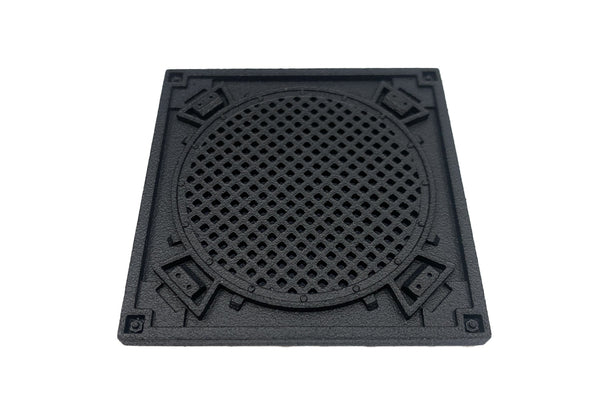Miniart 1:35 Dingo Mk II Pz. Kpfw. Mk I 202 (e) w/Crew
MIN35074
£32.00 GBP
Miniart 1:35 - Dingo Mk II Pz. Kpfw. Mk I 202 (e) w/Crew - Plastic Model Kit #35074
The Dingo was a small two-man armoured car, relatively low and wide enough to have the required stability for fast off-road rides. Its initial armour was thin, just enough to stand against infantry ordnance. At the Army’s request, it was thickened, reaching 30mm (1.18 in) on the front nose and glacis. Deflecting armoured sloped panels were welded all around the central framework. The front driving compartment had four opening hatches. The engine was the regular Daimler 6-cyl 2.5 l 55 hp (41 kW), fed by a 300 l (79.25 gal) gasoline reserve (two tanks), which gave an incredible long range for its small size. The transmission consisted of a pre-selector gearbox, fluid flywheel, five forward gears and five reverse gears, allowing steering with all four wheels. This feature gave the Dingo a very tight turning radius, only 7m (23 ft), but the system was tricky to master for inexperienced drivers, so a more conventional design with front-wheel steering was chosen for the Mk.II.
During the course of wartime production, it appeared that the flat bottom plate, which allowed the crossing of uneven ground, was highly vulnerable to mines. The rubber tires were of the run-flat semi-solid type, so no spares were carried, but their toughness was compensated by the massive vertical coil springs, to give a smooth ride. There was a swiveling seat next to the driver, for a machine-gun servant/radio operator, equipped with a N°19 wireless radio set. The base armament was a removable cal. 0.303 (7.7 mm) Bren gun, with a dozen spare magazines. This armament could be swapped over for a heavier Boys antitank rifle (cal 0.55 in/14 mm). This gave the vehicle, which was fast and well-protected, with a good engine and low profile, a real advantage against all sorts of light vehicles, making it perfectly suited for reconnaissance and liaison missions.
The Dingo was produced from 1939 to 1945, and remained virtually unaltered.
The Mark I had a flexible sliding roof and the all-wheel steering. It was difficult to handle for inexperienced drivers.
The Mark IA was a sub-variant equipped with a folding roof.
The Mark IB had a reverse cooling air flow and new armored grilles for the radiator, allowing better ventilation. The bulk of these vehicles served in the Libyan desert.
The Mark II had a revised steering system, using only the front wheels. The lighting equipment was modernised, altogether with the Mark IB modification range.
The Mark III was the final version, coming in 1944 with a waterproof ignition system and no roof at all.
The kit contains 262 parts.
Includes parts for one armoured car and two figures.
Box: 345mm x 240mm x 60mm
Related Items
Soviet Sniper WW2 1/16th scale
£45.00 GBP
Highly detailed 1/16th or 120mm scale miniature, capturing the uniform and equipment of a WW2 Soviet Sniper. The kit comes with three head configuration options, fur hat with ear flaps known as the 'Ushanka', a head with helmet (2 parts) and a head with a cap known as the 'Pilotka'.
This is ideal for a diorama or bust depicting Soviet Snipers such as Vasily Grigoryevich Zaitsev. Between 10 October 1942 and 17 December 1942, during the Battle of Stalingrad, he killed 225 enemy soldiers. Zaitsev became a celebrated figure during the war and later a Hero of the Soviet Union, and he remains lauded for his skills as a sniper.
Operation Frankton RMBPD Set - WWII Cockle Canoe + Royal Marines
£45.00 GBP
1:35 - Major Herbert George "Blondie" Hasler - Resin kit
Herbert George "Blondie" Hasler was a Lieutenant Colonel of the Royal Marines. In 1942, a 28-year-old Hasler planned and led Operation Frankton. The operation was a commando raid on Axis shipping in the French port of Bordeaux occupied by the Germans. The mission was to attach mines to the hulls of German cargo ships. Three of the five canoes were lost on the way to the port. The surviving crewmen including Hasler reached the port successfully, placed the mines and managed to drown four cargo ships. They then walked 100 miles to a French village where they met with members of the Resistance and started their journey back to England through Spain and Gibraltar. For this operation Hasler was awarded the Distinguished Service Order by King George VI.
One kayak was damaged while being deployed from the submarine, and it and its crew therefore could not take part in the mission. Only two of the 10 men who launched from the submarine survived the raid: Hasler, and his number two in the kayak, Bill Sparks. Of the other eight, six were executed by the Germans and two died from hypothermia.
This product is available in two scales, 1:35 and 1:24 and was painstakingly designed from scratch as a digital model.
The kit includes: 2 x miniatures (Blondie Hasler and Bill Sparks) in their folding Cockle Canoe named 'Catfish' made by Campaign Models (UK).
Now available, while stocks last.
Miniature Diorama Display Base
£9.50 GBP
This highly detailed Diorama base is ideal for mounting one or two figures on display. Small enough to be displayed easily, big enough to provide enough space to set the scene. More styles coming very soon!
Dimensions: 58mm x 58mm x 4mm
1:35 Resin Miniature WWII German Soldier Eastern Front
£15.00 GBP
A detailed single (1x) resin miniature in 1:35 scale, posed to be standing while smoking a cigarette. The kit consists of the following parts:
Head/torso
Helmet
Right arm with MP40
Left arm/hand
Left leg
Right leg
M1931 Bread Bag - with M1931 Field Flask and Mess tin combined
Ammunition Pouch
Spare MP40
Sidearm in holster




















